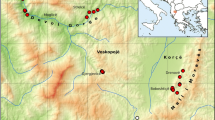Abstract
The Lord Howe Island Stick-insect (Dryococelus australis) was formerly abundant on Lord Howe Island, Australia, but was extirpated by Black Rats (Rattus rattus) in the 1920s. The species was thought to be extinct, until freshly dead remains were found by climbers on Balls Pyramid during the 1960s. In February 2001, a survey of Balls Pyramid led to the discovery of a small population of D. australis on a precipitous terrace 65 m above sea level. Two adults and one nymph (all females) were located feeding on an endemic tea-tree (Melaleuca howeana). An accumulation of plant debris at the base of the shrub, kept moist by water seepage, provided the insects with damp hollows suitable for use as daytime refugia. All evidence indicated that the species was confined to this single small terrace. A second survey, in March 2002, located a total of 24 D. australis. Twelve individuals were in the same shrub as that occupied the previous year, and 12 were dispersed among five nearby, smaller shrubs. Ten individuals were able to be sexed – eight females and two males. A number of threats to the population of D. australis on Balls Pyramid are identified and several management actions are proposed to ensure the conservation of the species.
Similar content being viewed by others
References
Atkinson I.A.E. 2001. Introduced mammals and models for restoration. Biological Conservation 99: 81–96.
Dubach J., Sajewicz A. and Pawley R. 1997. Parthenogenesis in the Arafuran file snake (Acrochordus arafurae). Herpetological Natural History 5: 11–18.
Edgecombe J. 1987. Lord Howe Island: World Heritage Area. Australian Environmental Publications, Balmain, Australia.
Etheridge R. 1889. The general zoology of Lord Howe Island. Australian Museum Memoirs 2: 3–42.
Gurney A.B. 1947. Notes on some remarkable Australian walkingsticks, including a synopsis of the genus Extatosoma (Orthoptera: Phasmatidae). Annuals of the Entomological Society of America 40: 373–396.
Higgins P.J. and Davies S.J.J.F. 1996. Handbook of Australian, New Zealand and Antarctic Birds.Vol. 3: Snipes to Pigeons. Oxford University Press, Melbourne, Australia.
Hindwood K.A. 1938. The extinct birds of Lord Howe Island. Australian Museum Magazine 6: 319–324.
Holland J. 2001. On the brink. Macleay Museum News 17: 4.
Hutton I. 1991. Birds of Lord Howe Island: Past and Present. Ian Hutton, Coffs Harbour, Australia.
Hutton I. 1998. The Australian Geographic Book of Lord Howe Island. Australian Geographic, Terrey Hills, Australia.
IUCN 1983. The IUCN Invertebrate Red Data Book. IUCN, Gland, Switzerland.
IUCN 2000. 2000 IUCN Red List of Threatened Species. IUCN, Gland, Switzerland.
Key K.H.L. 1991. Phasmatodea. In: CSIRO Division of Entomology, The Insects of Australia. Melbourne University Press, Carlton, Australia, pp. 394–409.
Lea A.M. 1916. Notes on the Lord Howe Island phasma, and on an associated longicorn beetle. Transcripts, Proceedings of the Royal Society of South Australia 40: 145–147.
Mandis Roberts Consultants 1999. Lord Howe Island World Heritage Property strategic plan for management. Mandis Roberts Consultants, Surry Hills, Australia.
Mazzini M. and Scali V. 1980. Ultrastructure and amino acid analysis of the eggs of the stick insects, Lonchodes pterodactylus Gray and Carausius morosus Br. (Phasmatodea: Heteronemiidae). International Journal of Insect Morphology and Embryology 9: 369–382.
McAlpine D.K. 1966. Rediscovery of Lord Howe Island phasmid. Australian Entomological Society News Bulletin 2: 71.
Montrouzier X. 1855. Essai sur la faune del'ile de Woodlark ou Moiou. Annales De La Societé D'Agriculture De Lyon 7: 1–114.
Murphy R.C. and Mowbray L.W. 1951. New light on the cahow (Pterodroma cahow). Auk 68: 266–280.
Opler P.A. 1976. The parade of passing species: extinctions past and present. Science Teachings 43: 30–34.
Paramonov S.J. 1963. Lord Howe Island, a riddle of the Pacific, Part III. Pacific Science 17: 361–373.
Pickard J. 1983. Vegetation of Lord Howe Island. Cunninghamii 1: 133–265.
Saunders A. and Brown D. 2001. An assessment of the feasibility of eradicating rodents from the Lord Howe Island Group. Endangered Species Recovery Council, Hamilton, Australia.
Smithers C.N. 1970. On some remains of the Lord Howe Island Phasmid (Dryococelus australis (Montrouzier)) (Phasmida) from Ball's Pyramid. Entomologist's Monthly Magazine 105: 252.
Standard J.C. 1967. Islands and seamounts to the east of Australia. Australian Natural History 15: 382–387.
Towns R.T., Daugherty C.H. and Cree A. 2001. Raising the prospects for a forgotten fauna: a review of 10 years of conservation effort for New Zealand reptiles. Biological Conservation 99: 3–16.
Veitch C.R. and Bell B.D. 1990. Eradication of introduced mammals from the islands of New Zealand. In: Towns D.R., Daugherty C.H. and Atkinson I.A.E. (eds), Ecological Restoration of New Zealand Islands. Department of Conservation, Wellington, New Zealand, pp. 137–146.
Verrill A.E. 1902. The ‘Cahow’ of the Bermudas, an extinct bird. Annals of the Magazine of Natural History 7: 26–31.
Westwood J.O. 1859. Catalogue of Orthopterous Insects in the Collection of the British Museum. Part 1, Phasmidae. Gurney and Jackson, London.
Wilkinson B.A. and Willson R.K. 1981. The Main Line Fleet of Burns Philip. The Nautical Association of Australia, Canberra, Australia.
Author information
Authors and Affiliations
Corresponding author
Rights and permissions
About this article
Cite this article
Priddel, D., Carlile, N., Humphrey, M. et al. Rediscovery of the ‘extinct’ Lord Howe Island stick-insect (Dryococelus australis (Montrouzier)) (Phasmatodea) and recommendations for its conservation. Biodiversity and Conservation 12, 1391–1403 (2003). https://doi.org/10.1023/A:1023625710011
Issue Date:
DOI: https://doi.org/10.1023/A:1023625710011




